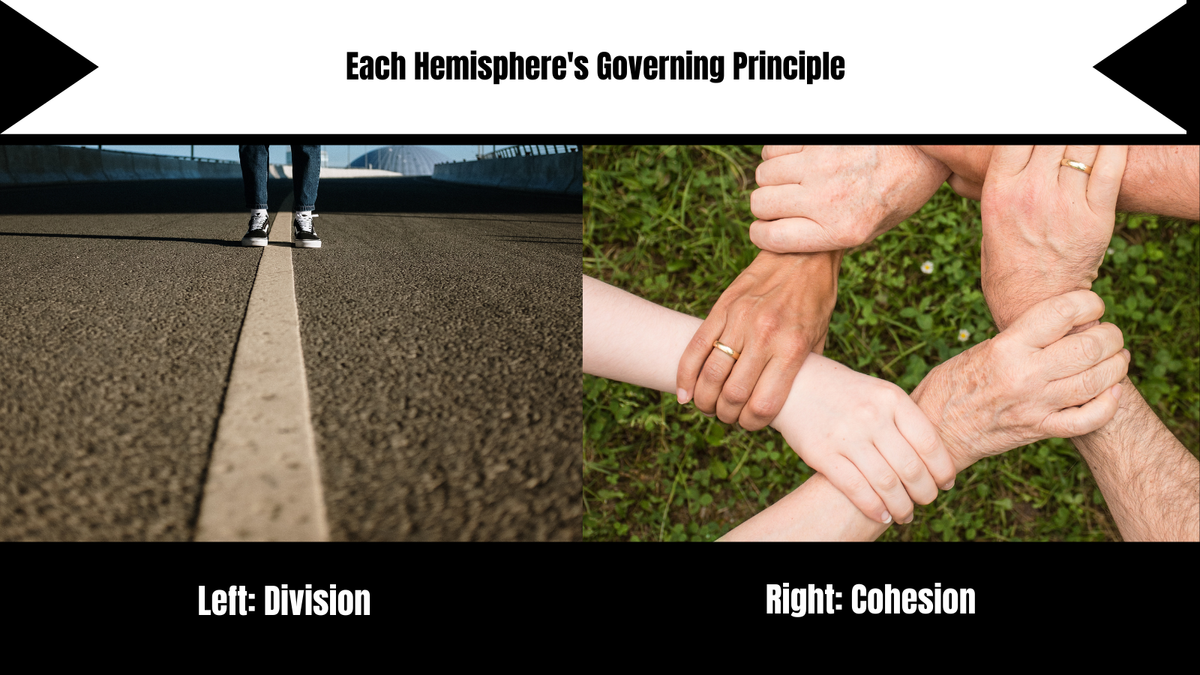Primer: Understanding the Hemisphere Hypothesis
Many smart people think Iain McGilchrist has effected a Copernican revolution in metaphysics. I tend to agree. Here's a summary of the revolution.

The Hemisphere Hypothesis

As a man is, so he sees. William Blake
The brain consists of two halves: the left hemisphere and the right hemisphere. In a healthy person, they work together constantly and do many of the same things. Both halves are necessary for a healthy existence (e.g., the right hemisphere controls the left hand; the left hemisphere controls the right hand).
But the left hemisphere and the right hemisphere attend to the world differently. Our attention affects the world, which in turn affects us. "[T]he nature of the attention we bring to bear on anything alters what we find there." The Master and His Emissary (Yale, 2009), 333.
If we pay attention to the world with the left, we get a world that looks like the left. If we pay attention to the world with the right, we get a world that looks like right. It’s a “vicious circle.” The Matter with Things (Perspectiva Press, 2022), 26.
The Tautology that Drives the Hemisphere Hypothesis
As a man is, so he sees. Who he is, then, determines how he sees. And how he sees determines what he finds. And what he finds affects how he is.
The Matter with Things, 17, 67 (paraphrase); The Master and His Emissary, 456
We are meant, in the final analysis, to attend to the world with the right hemisphere. The left hemisphere’s way of attending to the world is expedient. It’s meant to help the right hemisphere govern properly by bringing to the right hemisphere good information and handling mundane chores. It’s meant to be the servant — the emissary — of the right.
The person with a well-ordered soul will attend to the world with right hemisphere primacy. If a person attends to the world with left hemisphere primacy, he or she will have a disordered soul.
It’s that simple.
The Modern World is Way Too Tilted to the Left Hemisphere
The modern world is “Left Hemisphere Gone Wild.” The left hemisphere, which is meant to be an emissary for the right hemisphere, has usurped the right hemisphere’s master role. McGilchrist used a fable by Nietzsche to explain it:
There was a wise spiritual Master who looked after a small community so well that it flourished and grew. Eventually the Master realised that he could not take care of all his people’s needs on his own; more importantly, he realised that there were certain matters that he not only could not, but must not, become involved in, if he were to preserve his overview. He therefore appointed his brightest assistant to go about and do work on his behalf. Though bright, this emissary was not bright enough to know what it was he didn’t know. He became arrogant and resentful of the Master: ‘What does he know?’, he thought. ‘I’m the one that does the real work round here, I’m the one that really knows.’ And so he adopted the Master’s cloak, and pretended to be the Master. The emissary not knowing what it was he didn’t know, the community declined, and the story ends with the ruin of the community, including both the Master and the emissary.
Not ignorance, but ignorance of ignorance, is the death of knowledge. The right hemisphere, however, knows what it is that it must not get involved with. In the story that is why the Master (the right hemisphere) appoints the emissary in the first place.
The left hemisphere has been in control for a long time now and is apparently trying to shut out the right hemisphere altogether by blocking its ways of attending to the world, almost like some eerie artificial intelligence shutting down humanity. His bestseller from 2009, The Master and His Emissary, starts with science; proceeds through the millennia of western philosophy, literature, and history; and ends with a science fiction dystopian vision that, unfortunately, isn’t fiction.
We Need to Put Our Right Hemispheres Back in Control
McGilchrist’s message, to me, seems pretty clear: Each of us needs to struggle to put our right hemispheres back in control.
As more of us form our lives to assert the right hemisphere’s hegemony, the more society can start to escape the dystopia that we all sense is engulfing us but don’t know how to escape.
If we want to reassert the right hemisphere in our own lives, we need to understand how the two hemispheres look at things differently. We can then try to emphasize the right hemisphere attributes and quell the left hemisphere ones.
In other words, we need to “raise awareness” about how the two hemispheres attend to the world so we can attend to the world with the right hemisphere, which will, in turn, allow us to deploy the left hemisphere properly. (If you like Tolkien, you might like “The Elf Lays Down His Harp to Kill an Orc,” which shows the hemispheres in operation through Tolkien’s elf characters.)
I will soon be publishing a fairly comprehensive list of the different ways the hemispheres attend to the world. For now, I offer this handful of examples of their respective attributes for you to apply to your own life:
Right Hemisphere
The right hemisphere is interested in the big picture and the whole. It acts without a set purpose. It views truth as open and more of a process. It’s interested in possibilities. It appreciates intuition and the implicit . . . “poetic” knowledge that is fluid and changing. It’s interested in the left hemisphere’s opinions but never accepts them as final.
Left Hemisphere
The left hemisphere wants to grab and control. It manipulates and treats people and things as objects. It acts with purpose and focused attention. It divides and seeks certainty in the smaller, subdivided parts. It’s exclusively interested in its own opinions and (in a disordered soul) accepts them as final.
